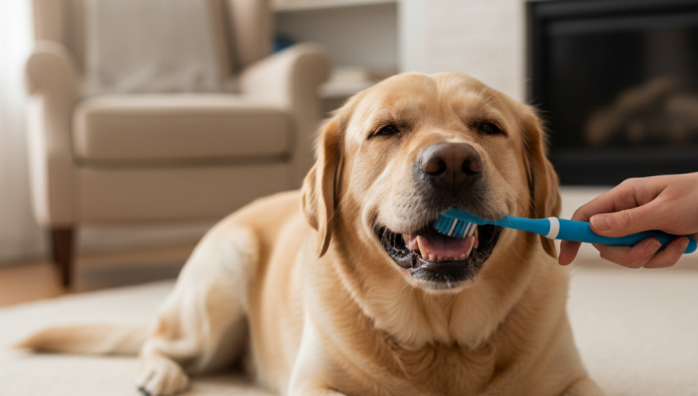How to Brush Your Dog's Teeth
by admin in Pet Care Basics 16 - Last Update November 18, 2025

I’ll be honest, for the longest time, I thought ‘doggy breath’ was just a normal part of having a dog. I’d wrinkle my nose when my old Golden, Max, would come in for a cuddle, and just accept it. It wasn\'t until a routine vet visit that I got a gentle but firm wake-up call about his dental health. That tartar buildup wasn\'t just cosmetic; it was the beginning of periodontal disease. I left that day feeling a mix of guilt and determination. I had to learn how to do this right, not just for his breath, but for his overall health.
Why brushing your dog\'s teeth is a game-changer
Before my vet chat, I truly didn\'t connect the dots between oral health and a dog\'s entire system. The vet explained that bacteria from plaque and tartar can enter the bloodstream and potentially affect the heart, kidneys, and liver. It was a huge \'aha\' moment for me. This wasn\'t about vanity; it was a fundamental part of responsible pet care, just like walks and proper nutrition. I realized that a few minutes of brushing each day could potentially add years to my best friend\'s life.
The simple toolkit I swear by
Getting started can feel overwhelming with all the products out there. I’ve learned that keeping it simple is the best approach. Here’s what’s in my dental kit:
- A Dog-Specific Toothbrush: I started with one of those little finger brushes, which was great for getting my dog used to the sensation. Now I use a dual-ended brush with a smaller head for tight spots and a larger one for the big surfaces. The angled handle really helps.
- Enzymatic Dog Toothpaste: This is non-negotiable. Human toothpaste is a huge no-no; ingredients like xylitol are extremely toxic to dogs. I opt for a poultry-flavored enzymatic paste. The enzymes help break down plaque, and the flavor makes it a treat, which was a huge breakthrough for us.
- Patience and High-Value Treats: This isn’t a tool you can buy, but it’s the most important one. I always have some of his favorite treats on hand to reward him after our session.
My step-by-step guide to a peaceful brushing session
The biggest mistake I made at first was trying to go all-in from day one. It became a wrestling match, and we both ended up stressed. I had to start over, and this slow, patient method is what finally worked for us.
Step 1: Make mouth-handling normal
For a few days, all I did was gently handle my dog’s muzzle and lift his lips for a second, then immediately gave him praise and a treat. I did this in short, happy sessions when he was already calm and relaxed.
Step 2: Introduce the toothpaste as a treat
Next, I put a tiny dab of the dog toothpaste on my finger and let him lick it off. He loved the flavor, which instantly created a positive association. We did this for a couple of days until he got excited when he saw the tube.
Step 3: Combine the brush and the treat
I then put a little toothpaste on the brush and just let him lick it off. I didn’t even try to brush yet. The goal was to make him see the toothbrush as a tasty delivery system, not a scary foreign object.
Step 4: The first gentle brush
Once he was comfortable with the brush, I gently brushed just one or two of his big canine teeth in a circular motion for a few seconds. Then, I immediately stopped, praised him like he’d just won an award, and gave him a treat. The key was to end on a high note before he had a chance to get anxious.
Step 5: Build up slowly
Over the next few weeks, I gradually increased the number of teeth I brushed and the duration of the session. Now, we can do his whole mouth in about two minutes. I still focus on the outside of the teeth, as that’s where most tartar builds up. It’s part of our daily evening routine, and he genuinely doesn’t mind it anymore.
What I\'ve learned from my fumbles
Don\'t force it. If your dog is stressed, stop and try again tomorrow with a smaller step. The goal is to build trust, not to win a battle. Consistency is far more important than perfection. A quick, imperfect brushing every day is a million times better than a perfect session once a month. Remember, this is a long-term commitment to your dog\'s health. While this routine has worked wonders for us, I always recommend chatting with your vet to make sure you have the best dental plan for your specific dog\'s needs.










